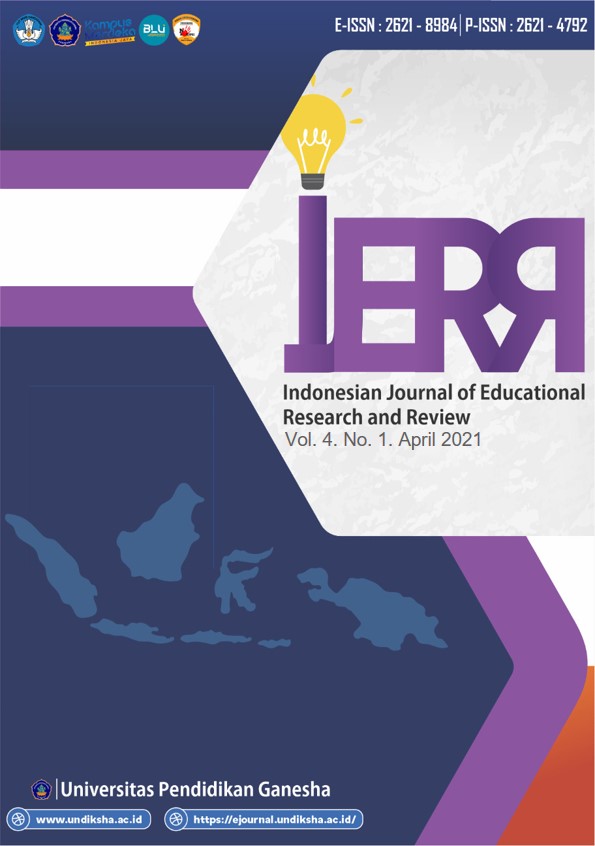Educational Technology and Principles and Methods of Teaching English
DOI:
https://doi.org/10.23887/ijerr.v4i1.33173Keywords:
Educational Technology, EnglishAbstract
The use of various audio-visual technologies in the teaching and learning process is very important. However, one of the most important teacher skills and knowledge is familiarity with this technology in English. The purpose of this study was to analyze the instructive innovation in the form of utilizing PC assets in learning English. The current investigation was led using enlightenment strategies accumulated by library procedures, which were collected taking into account educational innovations, related issues, articles, and books which have been referenced in the references. The results of this study show that encouraging guides as interfaces have options to do their job well. It would be better if the instructor had basic skills to use this device. Due to the problems of our nation's learning system in displaying English and the lack of trained students' skills, especially in speaking, listening, and writing, many guardians are trying to make up for this deficiency in the learning system by turning to state-of-the-art schools. Therefore, in this article, we have chosen to analyze the task of encouraging progress of assistance in promoting the teaching of English in the homeroom. So, it can be concluded that the use of PC resources, as well as e-learning, can help teachers in the classroom and remember that it enhances training ideas and makes students excited to learn.
References
Anderson, D. R., & Davidson, M. C. (2019). Receptive versus interactive video screens: A role for the brain’s default mode network in learning from media. Computers in Human Behavior, 99, 168–180. https://doi.org/10.1016/j.chb.2019.05.008.
Arrosagaray, M., González-Peiteado, M., Pino-Juste, M., & Rodríguez-López, B. (2019). A comparative study of Spanish adult students’ attitudes to ICT in classroom, blended and distance language learning modes. Computers and Education, 134, 31–40. https://doi.org/10.1016/j.compedu.2019.01.016.
Baker, J. P., Goodboy, A. K., Bowman, N. D., & Wright, A. A. (2018). Does teaching with PowerPoint increase students’ learning? A meta-analysis. Computers and Education, 126, 376–387. https://doi.org/10.1016/j.compedu.2018.08.003.
Chen, H. T. M., & Thomas, M. (2020). Effects of lecture video styles on engagement and learning. Educational Technology Research and Development, 68(5), 2147–2164. https://doi.org/10.1007/s11423-020-09757-6.
Chou, P. N., Chang, C. C., & Lu, P. F. (2015). Prezi versus PowerPoint: The effects of varied digital presentation tools on students’ learning performance. Computers and Education, 91, 73–82. https://doi.org/10.1016/j.compedu.2015.10.020.
Glaveanu, V. P., Ness, I. J., & de Saint Laurent, C. (2020). Creativity, Learning and Technology: Opportunities, Challenges and New Horizons. Creativity Research Journal, 32(1), 1–3. https://doi.org/10.1080/10400419.2020.1712167.
Gogate, M., Dashtipour, K., Adeel, A., & Hussain, A. (2020). CochleaNet: A robust language-independent audio-visual model for real-time speech enhancement. Information Fusion, 63, 273–285. https://doi.org/10.1016/j.inffus.2020.04.001.
Hao, M., Cao, W. H., Liu, Z. T., Wu, M., & Xiao, P. (2020). Visual-audio emotion recognition based on multi-task and ensemble learning with multiple features. Neurocomputing, 391, 42–51. https://doi.org/10.1016/j.neucom.2020.01.048.
Huang, Y., Richter, E., Kleickmann, T., Wiepke, A., & Richter, D. (2021). Classroom complexity affects student teachers’ behavior in a VR classroom. Computers and Education, 163, 104100. https://doi.org/10.1016/j.compedu.2020.104100.
Jurkovič, V. (2019). Online informal learning of English through smartphones in Slovenia. System, 80, 27–37. https://doi.org/10.1016/j.system.2018.10.007.
Lazonder, A. W., Walraven, A., Gijlers, H., & Janssen, N. (2020). Longitudinal assessment of digital literacy in children: Findings from a large Dutch single-school study. Computers and Education, 143(September 2019), 103681. https://doi.org/10.1016/j.compedu.2019.103681.
Liu, H., & Song, X. (2021). Exploring “Flow” in young Chinese EFL learners’ online English learning activities. System, 96, 102425. https://doi.org/10.1016/j.system.2020.102425.
Mayer, R. E., Fiorella, L., & Stull, A. (2020). Five ways to increase the effectiveness of instructional video. Educational Technology Research and Development, 68(3), 837–852. https://doi.org/10.1007/s11423-020-09749-6.
Ogawa, N., Kanematsu, H., Barry, D. M., Shirai, T., Kawaguchi, M., Yajima, K., Nakahira, K. T., Suzuki, S. N., Kobayashi, T., & Yoshitake, M. (2020). Active learning classes (in kosen colleges of Japan) using ICT and tools for obtaining biological information to enhance the creativity of engineering design students. Procedia Computer Science, 176, 2108–2116. https://doi.org/10.1016/j.procs.2020.09.247.
Scagnoli, N. I., Choo, J., & Tian, J. (2019). Students’ insights on the use of video lectures in online classes. British Journal of Educational Technology, 50(1), 399–414. https://doi.org/10.1111/bjet.12572.
Seçer, Ş. Y. E., Şahin, M., & Alcı, B. (2015). Investigating the Effect of Audio Visual Materials as Warm-up Activity in Aviation English Courses on Students’ Motivation and Participation at High School Level. Procedia - Social and Behavioral Sciences, 199, 120–128. https://doi.org/10.1016/j.sbspro.2015.07.495.
Valtonen, T., Kukkonen, J., Kontkanen, S., Sormunen, K., Dillon, P., & Sointu, E. (2015). The impact of authentic learning experiences with ICT on pre-service teachers’ intentions to use ICT for teaching and learning. Computers and Education, 81, 49–58. https://doi.org/10.1016/j.compedu.2014.09.008.
Downloads
Published
How to Cite
Issue
Section
License
Authors who publish with the Indonesian Journal of Educational Research and Review (IJERR) agree to the following terms:
- Authors retain copyright and grant the journal the right of first publication with the work simultaneously licensed under a Creative Commons Attribution-ShareAlike 4.0 International License. that allows others to share the work with an acknowledgment of the work's authorship and initial publication in this journal.
- Authors are able to enter into separate, additional contractual arrangements for the non-exclusive distribution of the journal's published version of the work (e.g., post it to an institutional repository or publish it in a book), with an acknowledgment of its initial publication in this journal.
- Authors are permitted and encouraged to post their work online (e.g., in institutional repositories or on their website) prior to and during the submission process, as it can lead to productive exchanges, as well as earlier and greater citation of published work. (See The Effect of Open Access)









